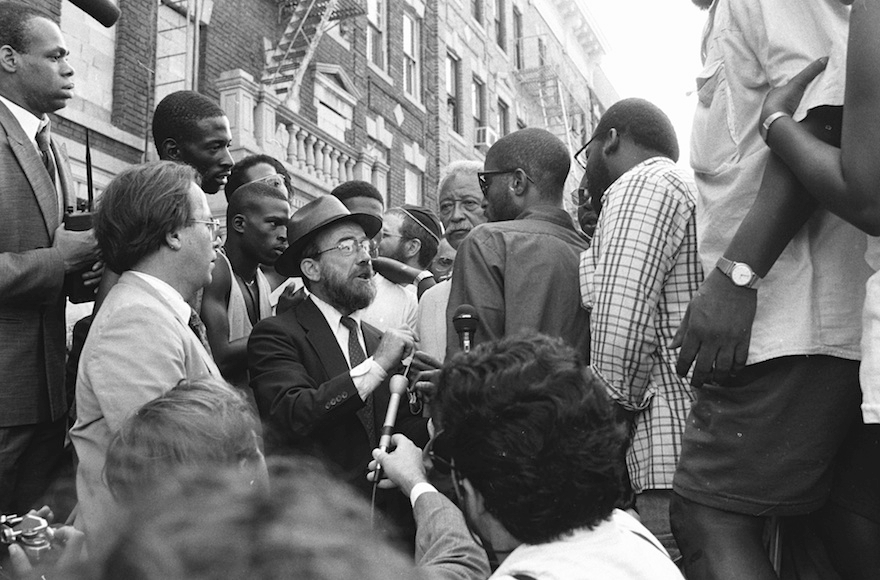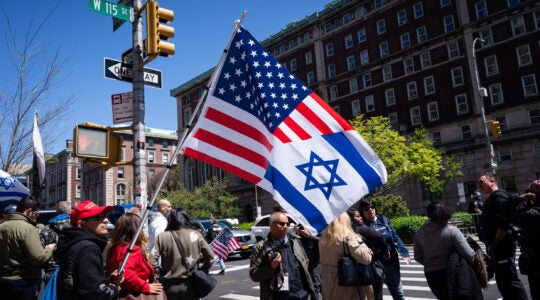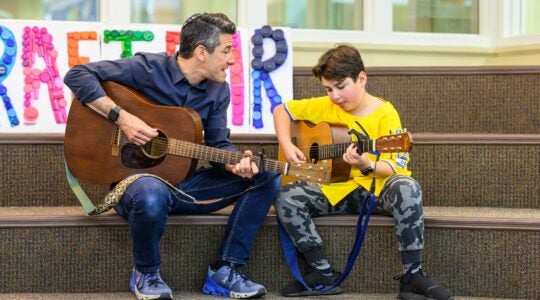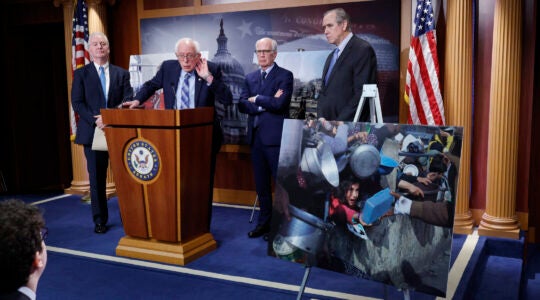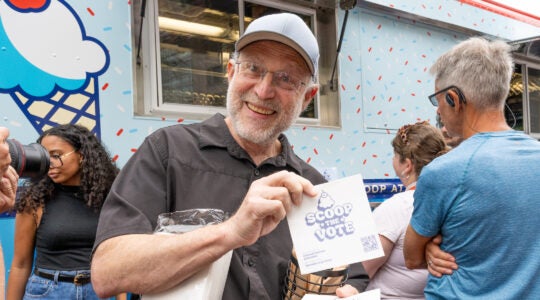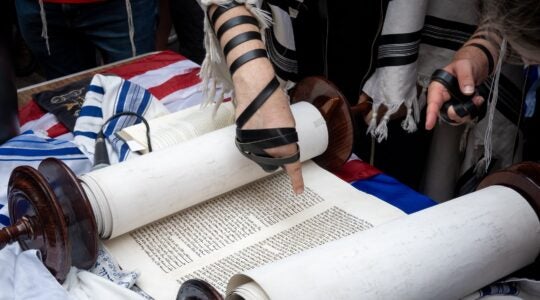NEW YORK (JTA) — Much has changed in Crown Heights in the past 25 years, since the accidental death of a black boy touched off three days of rioting in which black youths attacked religious Jews in the Brooklyn neighborhood.
Many called it a riot. Some Jews call the events of Aug. 19-21, 1991, a pogrom. And some blacks call it an uprising.
Yankel Rosenbaum, a graduate student affiliated with the area’s prominent Chabad-Lubavitch Hasidic movement, was killed when a group of black men stabbed and beat him, shattering his skull. Cars were overturned and set aflame. Bricks were thrown. Residents and reporters were pulled from cars and beaten. Stores were looted.
The violence left anguish in both communities, but also led to high-profile community programs intended to create racial reconciliation, many of which have since shut down.
And some scars, on both sides of the racial divide, have yet to completely heal.
But today is a very different time in Crown Heights, where charming limestone row houses line side streets and prewar apartment buildings sit tall on the avenues. A growing number of young professionals are moving in from pricier parts of Brownstone Brooklyn and Manhattan in search of more affordable rents. Fancy boutiques and coffee shops are proliferating. There’s even a Starbucks.
Today there is less open hostility between blacks and Jews, residents say, though still a high degree of separation, misunderstanding and suspicion. But there is far better communication between leaders of the respective communities, who are quick to quell misinformation when conflict occurs – which was part of what fed the rioting, according to a state-commissioned report issued in 1993.
And today, Crown Heights’ blacks and Jews share a common adversary: gentrification.
“What people would consider an ‘invading’ population is still white but it’s not just the Hasidim,” said Mark Winston Griffith, 53, executive director of the Brooklyn Movement Center, a community organizing group focused on issues of police and gun violence. “The tensions are no longer bilateral.”

Mark Winston Griffith, executive director of the Brooklyn Movement Center, says there is “not much more relationship between the communities than there was 25 years ago.” (Courtesy of Griffith)
In perhaps the strangest twist, one of the biggest sources of tensions is among Orthodox Jews, specifically modern Orthodox newcomers and haredi Lubavitch residents who have long called the neighborhood home.
The conflict has coalesced around a controversial new eruv erected around large parts of the neighborhood by a group affiliated with a growing modern Orthodox synagogue.
An eruv is a boundary of posts and thin wires essentially creating a fictitious private domain so that religious Jews can carry keys or push strollers on the Sabbath as they can on their own property. The new eruv has been vandalized repeatedly — so often that police are now investigating it as a hate crime.
Rhetoric coming from members of the Lubavitch community has been angry, at times even threatening. Some who carry religious items on Shabbat in the neighborhood say they have been harassed.
“One man walking with his young daughter and holding his tallit bag got screamed at” by a fellow Lubavitcher, said Naftali Hanau, who heads the eruv committtee at Congregation Kol Israel. According to Hanau, the man was told, “You’re worse than Hitler!”
Hanau, who will say only that he is in his 30s, is CEO of Grow And Behold, a company selling kosher, pasture-raised meat. He has lived in Crown Heights for eight years. Kol Israel, which erected the eruv, is located in Prospect Heights, just over the unofficial western border of Crown Heights. It cost supporters several thousand dollars to repair the vandalism, Hanau said, after they spent about $30,000 erecting the ritual boundary.
Eruvs are common in Orthodox communities worldwide, including those led by Lubavitch rabbis, though none has ever been sanctioned in Crown Heights itself. The Crown Heights rabbinical court, or beit din — which is part of the Lubavitch community — recently ruled against the eruv.
For eruv supporters, the boundary makes the neighborhood more welcoming for all observant Jews. Since the eruv was installed in mid-June, the number of people walking to Kol Israel from deeper into Crown Heights has increased, said Hanau. Conflict over the eruv is “really about control,” he said.
“The rabbis in Crown Heights are losing control of their flock. That’s what they’re screaming about,” Hanau said.
The neighborhood has long been the spiritual center of the Lubavitch movement, best known outside of the community for its outreach centers in hundreds of Jewish communities. But things have changed substantially within Lubavitch since its rebbe, Menachem Mendel Schneerson, died in 1994. Adults too young to have met Schneerson now live in the neighborhood, with some women not necessarily conforming to the standards of tzniut, or modesty, that were at one time ubiquitous. Posters hanging on light poles remind women to dress modestly.
The Lubavitch community “isn’t as cohesive as it once was,” said Yosef Rivkin, 31, who grew up in the Lubavitch community. “Leadership fell apart after 1994 and the rebbe died. A lot of factions went their own way.”
Rivkin no longer considers himself Lubavitch, but still lives in Crown Heights. He cites the growth of “class shuls,” or congregations formed by yeshiva friends. Others joined shteibels, or neighborhood congregations, as an alternative to praying at the main Crown Heights synagogue at 770 Eastern Parkway, known simply as “770.”
“The community has become multifaceted and multidirectional,” Rivkin said.
Many longtime Lubavitch residents view the eruv — and the newcomers it will bring — as an unwelcome incursion into the neighborhood that they have maintained through citywide race riots in the 1960s and ‘70s, white flight to the suburbs in the ‘70s and the Crown Heights unrest in 1991.
“The community has made sacrifices over the years” to keep the community going, said a Lubavitch man who works for one of the community’s central organizations but did not want to be named. “A little respect is due.”
Others agree that the eruv demonstrates a lack of “respect.”
“One shul out of 46 in the neighborhood decided there should be an eruv. That’s not an appropriate way of doing things,” said Rabbi Eli Cohen, executive director of the Crown Heights Jewish Community Council. Although the council is not formally affiliated with Chabad, its members, like Cohen, identify with the movement.
While members of the Jewish community disagree among themselves, relations between leaders from the Crown Heights Jewish and non-Jewish communities have improved since the riots.
“We talk with each other, we’re in contact with each other, we have the bonus of the social media metrics, we communicate when issues are happening,” said Richard Green, CEO of the Crown Heights Youth Collective.
Green, who is black and a longtime resident of Crown Heights, was centrally involved in working toward racial reconciliation in the riots’ aftermath.
“We do not allow what happened in 1991 to happen. People communicate more than ever before. Whenever there’s an issue that’s happening, folks talk it out,” he told JTA.
Amy Ellenbogen, director of the Crown Heights Community Mediation Center, agrees.
“In 1991, people didn’t even know who the leaders were to talk to each other. Now they’re Facebook friends,” said Ellenbogen, a self-described liberal Jew who lives in a different part of Brooklyn.
And there are periodic issues. Late one night last December a black man, who appeared to be mentally disturbed, entered 770 wielding a knife. Police and the Shomrim, the private Lubavitch security force, were called. When police confronted the man and he wouldn’t drop the knife, he was shot and killed.
In 2008, a 20-year-old black man, Andrew Charles, was beaten by a member of the Shmira, another civilian security patrol in Crown Heights. The Hasidic man convicted of the crime served a single day in jail and performed 25 days of community service. More recently, a vacant school bus outside a Lubavitch girls school was set ablaze. An 11-year-old was arrested recently for the incident.
Though a minority of Crown Heights residents are Jewish — the Crown Heights JCC’s Cohen estimates Jews are 20 to 25 percent of the area’s 100,000 residents — they continue to wield outsize influence, both in perception and reality.
Few groups are better than Hasidim at developing close relationships with elected officials and police, and maximizing access to government-funded programs. And that leads to resentment among some black residents of Crown Heights.
“The police presence has always been this really stark irony,” said Griffith, the community organizer, an African-American born and raised in Crown Heights. “True, there is a concentrated Hasidic population surrounded by black folks. But there’s always been a feeling of resentment that they are being protected, and there’s always the question, from whom? Because the Hasidim are so physically visible, it becomes a very dramatic visual statement that is made that their property, that those lives and livelihoods are more important than the black ones.
“That tension still exists,” he said. “But it’s not as acute as it was back then.”
Black residents see the cars driven by Jewish security patrol members, which have markings similar to police cars, and want to know “‘how do they end up getting those cop cars? How do they have so many resources?’ This is a vigilante group that has been given credibility and city support, it is completely baffling to people,” Ellenbogen said. “They are not coming to help people in the black community.”
The Mediation Center, where Ellenbogen has worked since 2002, began in 1991 in direct response to the riots, offering conflict resolution training to both the Jewish and black communities, and providing a place where people could work out disputes. In 2005 it changed its focus to address gun violence within the local black community.
Cultural misunderstandings continue to proliferate. Jews and blacks, many from the Caribbean, have little common cultural ground. Perceived slights — like a Jewish pedestrian accidentally bumping into a black resident and moving on without apologizing — lead to lasting resentment, said Ellenbogen.
“The perception is among blacks that they aren’t seen,” she said. Hasidic shop workers, following strict Orthodox tradition, won’t place change into the hands of a customer of the opposite sex. Instead, they put it on the counter. But when they do it with a black customer, the perception is “‘they don’t want to touch me because I’m black and they think I’m dirty,’” said Ellenbogen.
On the other hand, Chana Lightstone, 31, a Lubavitcher and mother to four young sons, recalls how a black man recently screamed at her, “The Jews, they f***ing have everything!” as she walked with two of her boys in a stroller. She suspected, however, that he was mentally unstable. Although she wasn’t living in Crown Heights during the riots, Lightstone acknowledges that racial suspicions linger. When she and her family recently moved onto an otherwise entirely black block, she said, “I was a little bit nervous,” she told JTA. “But everyone has been so warm and welcoming.”

Chana Lightstone, shown with her husband and three of their four children, said suspicions linger between Jews and blacks in Crown Heights but that her black neighbors have been “warm and welcoming.” (Courtesy of the Lightstone family)
A quarter century later, even what the riots should be called remains at issue. To Jews in the community it was a riot or even a pogrom. Some in the black community, Griffith said, would call it “an uprising.”
“There are people who feel like there was a trigger on something that was deep seated and real, and what we experienced was an outpouring of that legitimate anger,” he said. “There are discrepancies from education to police to social services provision.”
Repair the World, a progressive Jewish social justice organization that opened its New York City headquarters in a Crown Heights storefront two years ago, is working to ease the tensions. Among the members of its board of directors is Melanie Lewis, 38, an African-American, who was raised and still lives in the neighborhood where her parents have resided for over three decades.
Growing up she had no communication with Jews, Lewis said.
“Sometimes you’d be at the same park or walk past each other. Who does that? It was ‘why are we so different? Why is everything so isolated?’ There was no one to explain that,” she said.
Young volunteers from Repair the World now work with local black churches, senior centers and community gardens to help build capacity for other volunteers. The group’s storefront space also serves as a community resource, offering help with voter registration and public services, and a venue where community organizations — from an entrepreneurship program for black teens to a Jewish women’s prayer service — meet, said Cindy Greenberg, executive director of Repair the World New York City.
About two years ago, Lewis attended a Repair the World Shabbat dinner that brought together longtime African- and Caribbean-American residents and some of the liberal Jewish newcomers. It was the first time she had the chance to sit down and talk with Jews.
Yet despite the many efforts to connect the black and Jewish communities in the riot’s aftermath, most didn’t last.
Project CURE , for instance, began in response to the riots, and aimed to help the communities better understand each other. But when one of its founders, David Lazerson, moved from Crown Heights to Florida, the project moved with him and changed focus.
Several events to mark the 25th anniversary are scheduled. On Aug. 21, “One Crown Heights,” supported by an array of community groups and elected officials, will start with a commemoration at the Brooklyn Jewish Children’s Museum, in the heart of Lubavitch Crown Heights. The day continues with a neighborhood festival at a large local park located in a historically black part of the neighborhood now popular with affluent newcomers.
On Aug. 10, the Brooklyn Historical Society marked the 25th anniversary with oral history clips of the riots and a panel discussion involving Griffith and Cohen, among other local experts.
Commemorations aside, however, today there is “not much more relationship between the communities than there was 25 years ago,” Griffith said.
“It went from a sense of ‘lets hold hands’ to a realization that it was a superficial approach and you couldn’t address it without addressing the underlying concerns people had,” Griffin said. “There isn’t much deeper of a cross-cultural understanding than there was then.”
“There are two communities that basically have zero interaction except when something bad happens,” said Ben Faulding, who is both black and Jewish.
Known as Ziggy, Faulding, 32, has lived in Crown Heights for three years.
“When the only thing a Jewish person reads about a black person that entire month is about a violent incident, they’re going to remember the dangerous thing,” he said. “Therein lies the problem. It’s like a détente. Like a cold war. It’s separate. That sort of separation is where fear is born.”
Says Green of the Youth Collective, “There’s always more work to be done, but you try and diminish the issues every day.”
JTA has documented Jewish history in real-time for over a century. Keep our journalism strong by joining us in supporting independent, award-winning reporting.
